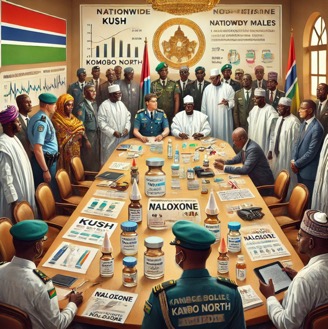
This is not a crisis we can pray away or hide behind our culture of masking problems. The harsh reality is that Kush does not discriminate. It cares not for your last name, your religious affiliations, or your socioeconomic background. Sooner or later, every family in The Gambia will feel its devastating touch. We can no longer afford to sensationalize victims on social media or treat this as someone else's problem. It is our collective crisis, our shared nightmare.
In the face of this escalating epidemic, health authorities and stakeholders should consider a bold new initiative: a comprehensive Naloxone program. This life-saving strategy is not just another band aid solution; it's a crucial step towards reclaiming our youth and our future. Building upon the tireless efforts of the National Taskforce for Drug and Substance Abuse, this program represents our best hope for turning the tide.
The time for half-measures and cultural silence has passed. We need sustainable solutions, and we need them now. Our children's lives hang in the balance, and with them, the future of The Gambia itself. Let this be a call to action, a rallying cry for every Gambian. The Kush Crisis is here, it's real, and it's time we faced it head-on, armed with compassion, science, and unwavering determination.
Current Situation:
According to the latest Situation Report (SITREP #03) dated 24th June 2024, The Gambia has seen a significant increase in suspected Kush-related cases:
- 113 total clinical cases reported, a 20% increase in just three weeks
- 11 suspected Kush-associated deaths, with a case fatality rate of 9.7%
- 107 individuals interdicted, including 73 Gambians and 34 foreign nationals
- 03 kilograms of Kush confiscated
The crisis predominantly affects young males, with 96% of cases being male and 54% falling within the 14-23 age group. The most affected district is Kombo North, accounting for 52% of cases.
Existing Response Measures:
The National Taskforce has implemented several crucial interventions:
- Regular coordination meetings
- Media engagements for public awareness
- Sensitization at border posts
- Collaboration with GSM operators and community organizations
- Continuous surveillance and case management
- Community engagement and health promotion activities
Building on these commendable efforts, the proposed Naloxone program aims to provide an additional layer of protection and response.
Understanding Naloxone and Its Role in Recovery:
Naloxone, also known by the brand name Narcan, is a medication designed to rapidly reverse opioid overdose. While Kush is not a traditional opioid, its unpredictable composition often includes opioid substances, making Naloxone a potential lifesaver in many Kush-related emergencies. However, the role of Naloxone extends beyond immediate overdose reversal and into the critical phase of post-overdose rehabilitation.
In conjunction with medications like buprenorphine, Naloxone forms a crucial part of medication-assisted treatment (MAT) for opioid addiction. Suboxone, a combination of buprenorphine and naloxone, has proven particularly effective in this regard. Buprenorphine helps manage cravings and withdrawal symptoms, while the presence of naloxone deters misuse of the medication. This combination allows individuals to stabilize their lives and engage more effectively in comprehensive recovery programs.
Naloxone is available in several forms:
- Nasal spray (Narcan): Easy to administer, requires no assembly.
- Injectable: Requires professional training to administer.
- Auto-injectable (Evzio): Designed for home use, with voice instructions.
The cost of Naloxone varies, with generic injectable versions costing as little as $20-$40 per dose, while Narcan nasal spray typically costs around $130-$140 for a kit containing two doses.
Implementing a Naloxone Program in The Gambia:
Mass Education:
- Launch a nationwide awareness campaign to educate the public about the risks of Kush use and the life-saving potential of Naloxone. This should include:
- Public service announcements on radio, television, and social media
- Educational programs in schools and community centers
- Informational materials distributed through healthcare facilities and pharmacies
Training:
Develop comprehensive training programs for various stakeholders:
- Law enforcement officers
- First responders, including Red Cross volunteers
- Healthcare professionals
- Community leaders and designated "neighborhood good Samaritans"
- Neighborhood shops and “Campeh/voos/bantabas”
- Pharmacy staff
Distribution:
Ensure wide availability of Naloxone through multiple channels:
- Equip all law enforcement officers and first responders with Naloxone kits
- Provide free Naloxone kits to trained community volunteers
- Incentivize pharmacies to offer free Naloxone upon request
- Establish Naloxone distribution centers in high-risk areas
Community Engagement:
Create a network of "Neighborhood Good Samaritans":
- Identify and train volunteers in each community
- Equip them with Naloxone kits and proper training
- Establish a rapid response system for overdose emergencies
Pharmacy and Drug Store Involvement:
Encourage pharmacies to play a crucial role:
- Offer training to pharmacy staff on Naloxone administration
- Provide incentives for pharmacies to dispense Naloxone free of charge
- Implement a tracking system to monitor Naloxone distribution and use
Data Collection and Analysis:
Establish a system to track Naloxone use and outcomes:
- Record all Naloxone administrations
- Analyze data to identify trends and high-risk areas
- Use insights to refine and improve the program
Potential Impact:
Beyond saving lives in immediate overdose situations, a comprehensive Naloxone and recovery program has the potential to significantly improve long-term outcomes for individuals struggling with Kush addiction. By providing a pathway to sustained recovery, this approach could help reintegrate affected individuals into society, preserving families and communities.
Based on experiences in the United States, a comprehensive Naloxone program has the potential to save thousands of lives. For example, between 1996 and 2014, lay people in the US reported reversing 26,463 opioid overdoses using Naloxone. In 2020 alone, over 93,000 lives were saved due to Naloxone administration.
Challenges and Considerations:
Implementing such a program in The Gambia will face unique challenges:
- Funding: Securing sustainable funding for Naloxone procurement and program implementation
- Cultural stigma: Overcoming negative perceptions about drug use and addiction
- Regulatory hurdles: Ensuring proper legal framework for widespread Naloxone distribution
- Supply chain management: Establishing reliable supply and distribution channels
- Overcoming stigma: Addressing societal attitudes towards addiction and recovery to ensure individuals receive the support they need
- Long-term funding: Securing resources not just for immediate interventions but for sustained recovery support
In the face of this unprecedented crisis, we must resist the temptation of "Statism" - the misguided notion that the public health system alone should shoulder the burden of implementation. History has shown us time and again that such an approach leads to inefficiency, bureaucratic bottlenecks, and ultimately, lives lost.
The success of Naloxone programs in other countries was not rooted in a government/state monopoly, but in smart partnerships. While the government played a crucial role as the primary payer and incentivizing agent, it was the private sector - with its established distribution networks and deep community roots - that provided the agile, efficient implementation needed to save lives.
We cannot afford to reinvent the wheel or create new bureaucracies when we have a vibrant private healthcare sector already embedded in our communities. By leveraging these existing structures, we can not only ensure faster, more effective distribution of Naloxone, but also stimulate job creation and economic growth at the local level.
This is not the time for endless workshops and capacity-building seminars that lead nowhere. We need a sustainable, community-led approach with a clear plan to ensure Naloxone is always readily available to save a life. The government's role should be to set standards, provide funding, and create incentives - not to micromanage distribution or create new layers of bureaucracy.
In this crisis, every second counts. We must embrace a model that combines the resources and oversight of the government with the efficiency and community connections of the private sector. Only through such a partnership can we hope to stem the tide of this epidemic and protect our youth. The stakes are too high for anything less than our most efficient, most effective response.
Comprehensive Recovery Support:
- Establish rehabilitation facilities that prioritize evidence-based pharmacological interventions alongside psychosocial support
- Develop long-term support programs that extend beyond initial hospital discharge
- Create a network of clinical, familial, and community support for individuals in recovery
- Implement programs to address the stigma associated with addiction and recovery
The true Journey begins after the emergency.
The role of Naloxone extends beyond immediate overdose reversal and into the critical phase of post-overdose rehabilitation. In conjunction with medications like buprenorphine, Naloxone forms a crucial part of medication-assisted treatment (MAT) for opioid addiction. Suboxone, a combination of buprenorphine and naloxone, has proven particularly effective in this regard. Buprenorphine helps manage cravings and withdrawal symptoms, while the presence of naloxone deters misuse of the medication. This combination allows individuals to stabilize their lives and engage more effectively in comprehensive recovery programs.
The establishment of rehabilitation facilities should prioritize the use of these evidence-based pharmacological interventions alongside psychosocial support. However, it's crucial to recognize that the journey to recovery doesn't end when a patient leaves the hospital after surviving an overdose. Rather, this marks the beginning of a long and often arduous path to sustained sobriety. Recovery requires a robust support system encompassing clinical care, family involvement, and community backing.
The insidious nature of addiction often alienates users from their loved ones, making the road to recovery even more challenging. It's imperative that society views the actions of those struggling with addiction through the lens of deep human suffering rather than moral failing. Offering ample doses of grace, compassion, and understanding is crucial in supporting individuals until their higher, better selves resurface. This approach not only aids in personal recovery but also helps reintegrate individuals as valuable members of society.
The stigma surrounding addiction and recovery often presents a significant barrier to seeking and maintaining treatment. It's essential to foster a culture of empathy and support, recognizing that addiction is a complex health issue rather than a character flaw. By combining evidence-based medical interventions like Naloxone and Suboxone with comprehensive psychosocial support and a compassionate societal approach, we can create a more effective and humane response to the Kush crisis in The Gambia. This holistic strategy not only saves lives in the short term but also offers hope for long-term recovery and reintegration, preserving the potential of affected individuals and strengthening the fabric of Gambian society.
Conclusion:
A comprehensive Naloxone program in The Gambia represents a proactive and potentially life-saving approach to complement the existing efforts against the Kush crisis. By building upon the strong foundation laid by the National Taskforce for Drug and Substance Abuse and learning from successful models implemented in other countries, this initiative could significantly reduce overdose deaths and provide a crucial window of opportunity for individuals to seek treatment and recovery.
The program's success will depend on strong governmental support, community engagement, and a shift in societal attitudes towards addiction and harm reduction strategies. By combining the proposed Naloxone program with the ongoing surveillance, awareness, and interdiction efforts, The Gambia can present a united and multi-faceted front against the Kush crisis, potentially saving countless lives and preserving the future of its youth.
In peace, love and good health,
Dr. IDB.
For more information, follow the work of Dr. Badjie and his Innovarx WOW team on www.igh.gm and on social media @innovarxglobal or call +2866200.
Disclaimer: The information provided in this article is for general understanding and does not constitute a diagnosis. For specific concerns or detailed health advice, always consult your designated healthcare professional.




